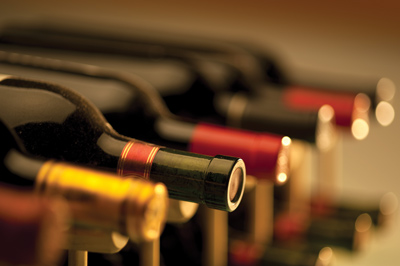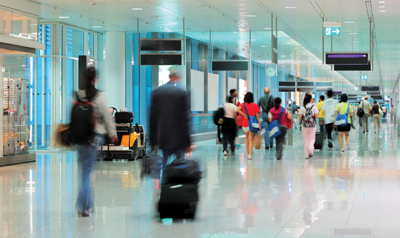CURRENT TOPICS
IT'S A FACT: MORE HUNTERS IN THE WOODS AND FIELDS
The number of hunters is rising. Reversing a trend of several years, there were an estimated 13.7 million hunters out looking for game in 2011. That's 1.2 million more than in 2010 according to the U.S. Fish and Wildlife Service. Numbers for 2012 are not yet compiled.
PICKPOCKETS MAY BE ON THE STREETS, IN AIRPORTS
By some statistics, travelers are safer than ever from petty crime in airports thanks to crowds of security officers and cameras. But pickpocketing and purse snatching are still common in airports. Marcus Felson, a criminology professor at Texas State University in San Marcos, says tourist crime is high. Quoted in The Wall Street Journal, Felson says tourists worldwide are victimized at much higher rates than local residents.
Pickpocketing has declined except for such classic spots as horse racing tracks. Boisterous and crowded events, such as in New Orleans during the Mardi Gras, are hot spots as are crowded public transportation and crowded city streets.
Thieving techniques include unzipping a strolling victim's purse to lift a wallet or phone. Another tactic: stopping suddenly to make the victim behind bump into him while a thief behind the victim removes a wallet from a back pocket. Women have had purses grabbed by a passing motorcycle rider.
Pickpocket protectors:
- Use a purse with a short strap so the opening fits securely under the armpit. Credit cards and cash are best carried in front pockets. Consider a "dummy wallet" in a back pocket filled with blank sheets of paper.
- Only use ATMs inside banks. Slide your finger across the card slot to check for anything that could "skim" the card data.
- If you are robbed, call your credit card company immediately as well as one of the three major credit reporting agencies, Experian, Equifax or TransUnion, to request a fraud alert.
- Check your accounts for small charges which thieves know often get through without being checked by central computers.
- If you lose your passport contact the nearest U.S. embassy or consulate for documents to help you get home
BOTTLE CAP'S BIRTHDAY
The crimp top bottle cap was patented by William Painter on February 2, 1892. He called it, and it's still officially known as, the disposable crown cork bottle cap.
CON ARTISTS STILL WORK THE 'FORECLOSURE RESCUE' GAME
Because some homeowners are unable to make their mortgage payments they may grasp for any plan they think will help them avoid foreclosure. They might even come up with thousands of dollars to pay unscrupulous con men. Here's how the frauds work:
- Scammers set themselves up with an official sounding name, one similar to a legitimate organization, and claim to be approved to make loan modifications. After taking $4,000 of the homeowner's money they disappear.
- In another fraud, scammer companies send a salesperson to call on homeowners and say they can audit their mortgage documents and use the violations to force their lender to approve a loan modification. They tell people they have found violations 90 percent of the time. These types of scams typically ask for $1,000 to $5,000 from the homeowner.
- One con man collected $2.8 million from various homeowners by promising them he could guarantee a loan modification under the Home Affordable Modification Program (HAMP). He told them to stop making their payments and to avoid contact with their lenders. Some of his victims would have been able to modify their mortgages if they hadn't stopped making the payments.
- Three scammers were arrested on charges of fraud against California homeowners. In addition to requiring up front fees in exchange for loan modification assistance, they told one homeowner to reject his lender's offer of a loan modification because they could get a better deal. Instead, the home was lost to foreclosure within four months.
- The attorneys general settlement with the five largest mortgage lenders brought out a new group of people who call homeowners and tell them they represent the lender. They request $500 or more to facilitate the homeowners getting money from the settlement. The homeowner never gets anything.
THE TECHNOLOGY OF WINE STORAGE
The number of individual wine cellars is growing. As more people remodel their home's lower levels a wine cellar is a great addition because they are staying in their homes longer and entertaining more. Wine cellars lend themselves to that trend. Another popular location is on the main floor near the kitchen. In either case, they can show off their wine collections.
For collectors without a wine cellar, keeping wine at 55 to 57 degrees is their main goal. Fluctuating temperatures are a big problem so they shouldn't chill a bottle in the fridge then return it to the cellar. It should always be kept out of sunlight.
For enthusiasts, wine coolers are available sized for 12 to 28 bottles. Prices range from $80 to hundreds. For those who enjoy an occasional glass of wine, built in cabinets with special wine slots are recommended. Budget minded wine lovers can always use an inexpensive wine rack. It can be painted to match the kitchen.

IT TOOK 65 YEARS TO DEVELOP BAR CODE TECHNOLOGY THAT TOOK OVER THE WORLD
The first step toward today's bar codes came in 1948 when Bernard Silver, a graduate student, overheard a conversation in the halls of Philadelphia's Drexel Institute of Technology. The president of a food chain was pleading with one of the deans to undertake research on capturing product information automatically at checkout. After hearing the conversation, Silver and N. Joseph Woodland, an instructor at Drexel, accepted the challenge. They first built a product that would glow under ultraviolet light but it was expensive and not dependable.
According to www.barcoding.com, Woodland dropped out of school and moved to his grandfather's apartment to concentrate on the product. One day, while sitting on a beach and making patterns in the sand with his hands, he got the idea of using lengthened versions of Morse Code dots and dashes and making some bars wider or narrower than others. He patented the idea in 1949, and a preliminary version of the bar code was born.
The technology had four features that ultimately let it take over the world, reports Bloomberg Businessweek.
- The bar code is simple and reliable. Before its time, punch cards were used for inventory calculations, but they were inaccurate and required expensive time and equipment to operate.
- A governing body of retailers and manufacturers was formed to develop standards. It chose the UPC, IBM's barcode system that Woodland helped develop after taking a job at IBM.
- A lengthy and expensive effort to seed and develop markets started with Bank of America's famous move to send a credit card to every home in San Francisco. It worked.
- For UPCs, seeding of the market was followed by the rise of Walmart Stores which used the code to create its efficient distribution system.
- The fourth ingredient was openness. Allowing everyone to build their own version of the technology.
Recently, Google persuaded Asian phone makers to adopt its Android system by offering an open source version of the bar code that they could change if they wanted to.

TRAVEL BAG FYI ON AIRPORT SECURITY
Complaints are rising on what travelers say is inconsistency on Transportation Security Administration's procedures. Some inconsistencies relate to flying within the United States compared to flying from a foreign country into the United States. It helps to know these rules:
- Within the United States, you can buy bottled water once inside security screening and take it on the plane. On flights from some Latin American countries the bottled water is confiscated.
- You might think that once TSA checks your ID at the front of the security screening line you are done with it. But the TSA is conducting surprise ID checks at boarding gates. They might ask to see your driver's license.
- If you belong to the Trusted Traveler Program you may get sent to regular screening anyway. There is no explanation.
- If you printed your boarding pass in advance you might still be sent back to the airline ticket counters because TSA's barcode reader has found the boarding pass code unreadable.
- When you go through a body scanner you may or may not be able to carry your wallet, money and credit cards in your hand so they won't get lost on an x-ray belt. TSA checkpoints impose different requirements at different times.
- Bottles of alcohol bought at duty free stores and delivered to you at boarding are exempt from liquid limitations even in Latin American countries where water bottles are prohibited. But if you have a connecting flight after entering the United States, any liquids not in quart size plastic bags must go into luggage.
- You can bring a scissors onto an airplane but only if the blades are shorter than four inches.

